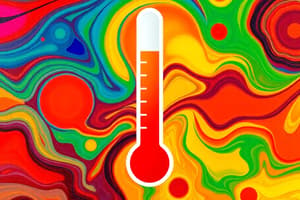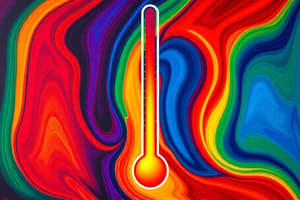Podcast
Questions and Answers
What does temperature measure?
What does temperature measure?
The average kinetic energy of the particles in an object.
How is temperature different than thermal energy?
How is temperature different than thermal energy?
Temperature measures the average energy of motion of the particles, while thermal energy is the total energy of all the particles' motion.
What is the difference between heat and temperature?
What is the difference between heat and temperature?
Heat is the transfer of thermal energy, while temperature is a measure of how hot or cold something is.
What is the difference between heat and thermal energy?
What is the difference between heat and thermal energy?
Provide freezing points and boiling points for each of the three different temperature scales.
Provide freezing points and boiling points for each of the three different temperature scales.
Describe absolute zero. Provide the temperature for absolute zero on each of the three temperature scales.
Describe absolute zero. Provide the temperature for absolute zero on each of the three temperature scales.
What does thermal energy depend on?
What does thermal energy depend on?
Know how thermal energy is transferred between objects. Give two examples of ways in which heat is transferred.
Know how thermal energy is transferred between objects. Give two examples of ways in which heat is transferred.
List and describe the three ways in which heat can be transferred. Provide one example each of ways we see that heat being transferred.
List and describe the three ways in which heat can be transferred. Provide one example each of ways we see that heat being transferred.
Describe what a conductor is. Provide an example.
Describe what a conductor is. Provide an example.
Do all objects change temperatures at the same speed? Why or why not?
Do all objects change temperatures at the same speed? Why or why not?
What would happen if thermal expansion were not taken into account when building certain objects (power lines, bridges, etc.)?
What would happen if thermal expansion were not taken into account when building certain objects (power lines, bridges, etc.)?
What is the difference between convection and a convection current?
What is the difference between convection and a convection current?
Flashcards
Temperature
Temperature
A measure of the average kinetic energy of particles within an object.
Thermal Energy
Thermal Energy
The total energy of motion of all particles in a substance.
Heat
Heat
The transfer of thermal energy from a warmer object to a cooler object due to a temperature difference.
Absolute Zero
Absolute Zero
Signup and view all the flashcards
Conductor
Conductor
Signup and view all the flashcards
Specific Heat Capacity
Specific Heat Capacity
Signup and view all the flashcards
Thermal Expansion
Thermal Expansion
Signup and view all the flashcards
Conduction
Conduction
Signup and view all the flashcards
Convection
Convection
Signup and view all the flashcards
Radiation
Radiation
Signup and view all the flashcards
Convection Current
Convection Current
Signup and view all the flashcards
Fahrenheit Scale
Fahrenheit Scale
Signup and view all the flashcards
Celsius Scale
Celsius Scale
Signup and view all the flashcards
Study Notes
Temperature and Energy Concepts
- Temperature measures the average kinetic energy of particles in an object.
- Thermal energy refers to the total energy of motion of all particles in a substance.
- Distinction between temperature and thermal energy: temperature indicates how hot or cold something is, whereas thermal energy encompasses the total energy of motion.
Heat and Thermal Energy
- Heat represents the transfer of thermal energy from a warmer object to a cooler object due to a temperature difference.
- Difference between heat and thermal energy: heat is the energy in transit, while thermal energy is the total energy within an object.
Temperature Scales
- Fahrenheit Scale: Freezes at 32°F, boils at 212°F.
- Celsius Scale: Freezes at 0°C, boils at 100°C.
- Kelvin Scale: Freezes at 273K, boils at 373K.
Absolute Zero
- Absolute zero is the theoretical lowest temperature, where no kinetic energy exists.
- Temperature of absolute zero: -273°C, -459°F, and 0K.
Factors Affecting Thermal Energy
- Thermal energy is influenced by the object's temperature, number of particles, and proximity of particles.
Methods of Heat Transfer
- Thermal energy transfers through conduction (e.g., food being grilled), convection (e.g., people swimming in warmed water), and radiation (e.g., sun heating sand).
- Convection involves fluid movement, whereas conduction transfers heat between particles directly.
Conductors
- Conductors are materials that facilitate heat transfer effectively, such as metals like silver or tile.
Changes in Temperature
- Different materials require varying amounts of thermal energy to change temperature, due to distinct properties, leading to different rates of temperature change across materials.
Thermal Expansion Considerations
- Ignoring thermal expansion in construction could lead to catastrophic failures, such as explosions or power outages, especially in infrastructure like power lines and bridges.
Convection versus Convection Current
- Convection is the actual process of heat transfer, while a convection current describes the circular motion caused by temperature differences in fluids.
Studying That Suits You
Use AI to generate personalized quizzes and flashcards to suit your learning preferences.




